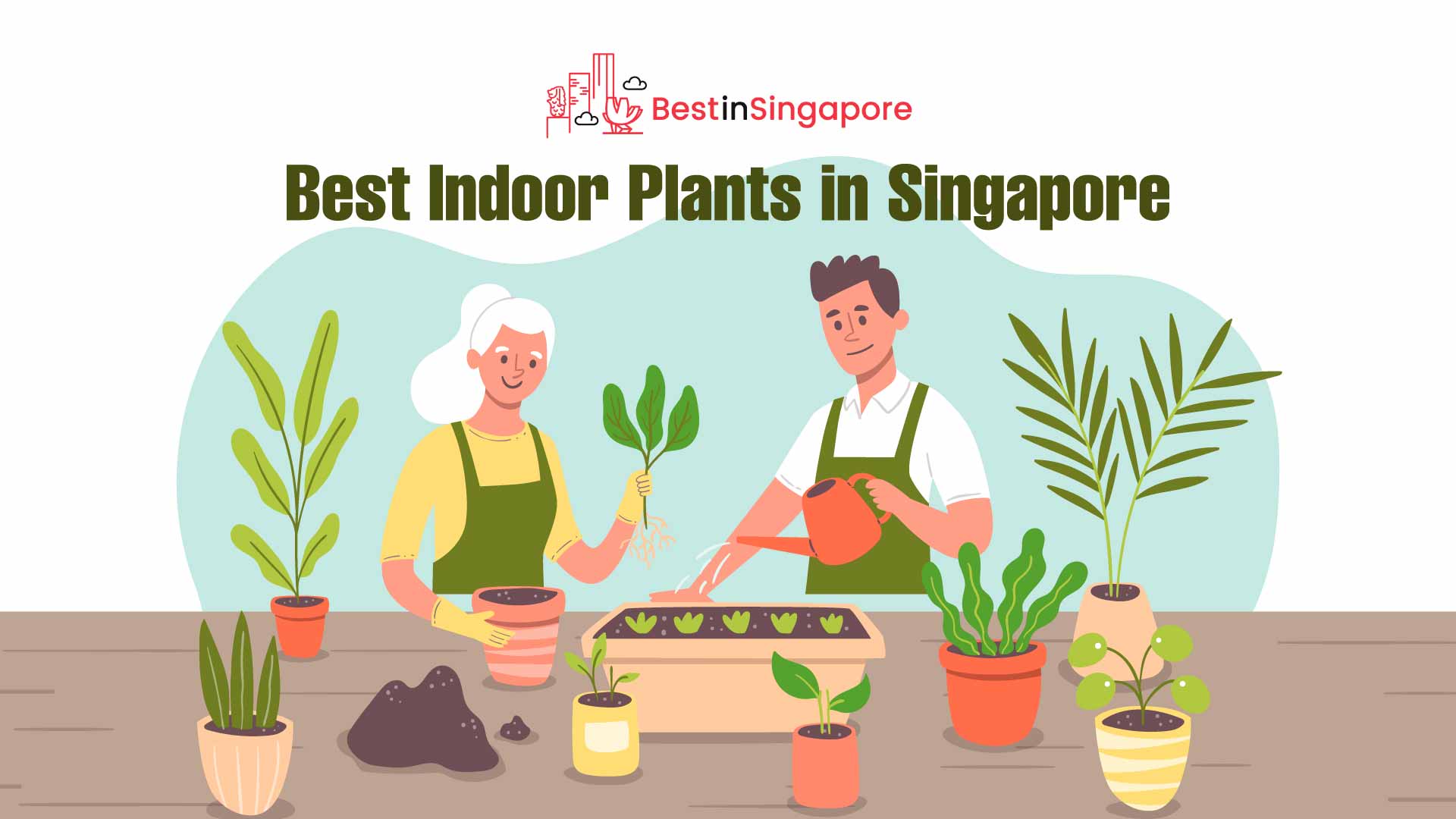7 Best Indoor Plants in Singapore to Grow at Home (2023)
Looking for something to brighten up the interiors of your home? Maybe now’s the perfect time to decorate your home with the best indoor plants in Singapore for your home that are low maintenance and hardy.
There’s no better way to improve your home’s interiors than by placing the best indoor houseplants in Singapore in every room. Not only are they pleasant to look at, but they can keep indoor air circulation clean and fresh too.
Anyway, we found some of the best indoor plants in Singapore that can both purify and beautify your home, without needing a lot of maintenance. We also included a few factors to consider before getting a houseplant and how to take care of them.
Check them out below!
What to Consider When Choosing the Best Indoor Plants in Singapore
Introducing houseplants to your home is always an exciting venture, but there are some things you have to consider before taking home any indoor plants.
You don’t want to end up with dead house plants after only a week because you failed to take note of other important things. If this is your first time buying indoor plants, worry no more because we have you covered.
Here are a few things to keep in mind before looking for the best indoor plants in Singapore.
1. Space
One of the most common mistakes that first-time indoor plant owners commit is squeezing them between small, tight spaces. Unless you want to kill your plants in less than a week, don’t do this.
Placing houseplants between things or behind furniture only blocks their source of sunlight and airflow, making it difficult for them to breathe.
To increase the chances of your indoor plants surviving in Singapore, make sure to keep at least 15 centimetres of space between them and any other household item. If possible, place them in a spot with good air circulation and where they can get sufficient sunlight.
It also helps to bring your indoor plants in Singapore out to a windowed room at least twice a week to get them refreshed.
2. Sunlight
Speaking of sunlight, the amount of sunlight that each room gets is a huge factor in keeping an indoor plant in Singapore alive. Allow the amount of sunlight that your room gets in guiding you towards picking the best indoor plants in Singapore.
Bright-light plants must receive strong sunlight every day in order to survive, while medium-light plants can survive even with filtered or indirect sunlight.
If you have a low-light room, then we strongly recommend going for low-light plants. This type of houseplants requires a minimal amount of sunlight, which explains why most people choose them.
3. Humidity
It’s worth noting that certain indoor plants require more humidity than others, so make sure to research ahead about the houseplant you’re eyeing for.
Most indoor locations have relatively low humidity due to heating and air conditioners that dry the air out. It’s best to keep your indoor plants in Singapore away from items that may dry out their moisture such as air conditioners, humidifiers, and radiators.
Going for tropical houseplants will require owners to monitor the moisture levels inside their home regularly. If you’re not up to that challenge, we recommend choosing non-tropical houseplants.
4. Temperature
Temperature is another important factor in the growth of the best indoor plants in Singapore. One thing to keep in mind about temperature is that air conditioning causes the soil to dry out more slowly.
Likewise, radiant heat causes plants and their soil to dry out faster, which is another reason to keep your houseplants away from air conditioning units and radiators.
During summer, it’s best to lessen your houseplants water-intake as long as the air conditioning is keeping your home cool.
How to Take Care of the Best Indoor Plants in Singapore
Even the most low-maintenance indoor plants in Singapore need some loving and attention from their owners. It’s impossible to decorate your homes with houseplants and then leave them on their own to survive.
As plant owners, you have to take care of them one way or another. Here are some tips on how to keep your houseplants alive.
Watering plants
Watering plants is one of the most time-consuming parts of plant care. If the soil is kept too damp or dry, the plant’s roots will begin to die, leaning to inadequate growth, or worse, death of the plant.
The ideal way to go about watering plants is to first check the soil. If the potting soil has become lighter in colour or has started to crack, it probably needs to be watered.
You’ll be able to tell if the plant has enough water or needs more by sticking a finger into the soil and assessing the wetness or dryness.
Some of the most common signs of under-watering are slow leaf growth, translucent leaves, and brown or yellow leaf edges.
On the other hand, an indoor plant is overwatered when there are fungi or mould on the soil, stinky roots, leaves with brown rotten patches, and young and old leaves falling at the same time.
Fertilising plants
The importance of watering plants needs no explaining, but most plant owners overlook the importance of fertilisers. Houseplants extract nutrients from the soil but over time, that soil will become depleted.
When that happens, this is where fertilisers are needed to keep the soil rich with nutrients to keep your houseplants healthy and happy.
Using fertilisers once a month is enough when your indoor plants in Singapore are flowering and growing. During wet seasons, when houseplants are dormant, there’s no need to use fertilisers.
Wiping plants
Even the best indoor plants in Singapore are always susceptible to dust that circulates inside your home, leading to all sorts of problems. Dust can clog the pores of the leaves and block light absorption, keeping transpiration from taking place.
It’s recommended to carefully wipe your plant’s leaves with a moist paper towel at least once a week.
Clipping plants
It’s equally important to trim back overgrown stems and cut off dead leaves regularly to help your indoor plants grow to their fullest potential and maintain their fresh and healthy appearance.
Repotting plants
Once your houseplants have started growing successfully, they will eventually need a larger pot to encourage further growth. We recommend a size larger than their current container, but not too large.
Going for a pot that’s too large for your plant may cause root problems because the soil will remain wet for a couple of days, sometimes even for a couple of weeks.
You have to be extra careful with the root system to avoid damage. When transferring your indoor plant, carefully firm the soil around the root ball without compacting it, and then leave an ample amount of space at the top of the new container.
The Best Indoor Plants in Singapore
Now that you know the things you have to consider before getting an indoor plant and the ways to take care of them, now’s the time to reveal our picks for the best indoor plants in Singapore.
1. Snake Plant
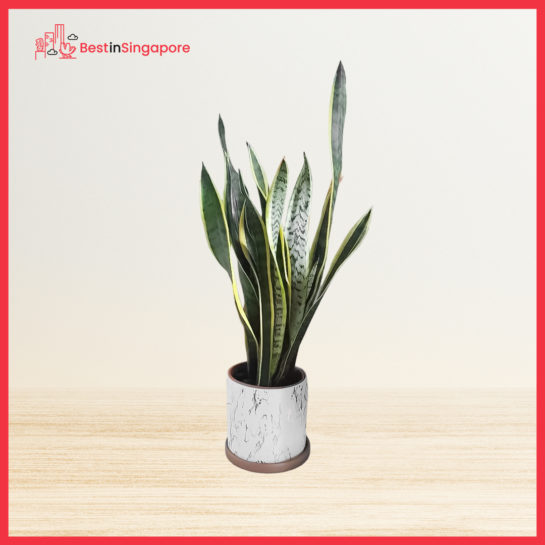
| BEST FEATURE | Can purify and clean air |
| SCIENTIFIC NAME | Sansevieria trifasciata |
| SIZE | Approximately 60cm (vary in sizes) |
| PRICE | S$23.85 |
Snake plants, sometimes called Mother-in-Law’s Tongue, are famous for its air-purifying properties. Because of the benefits it offers, it’s one of the most common indoor plant on the island.
In terms of maintenance, snake plants don’t require as much attention from its owners as most indoor plants. It’s a houseplant that thrives in warm temperatures and can survive even in low-light surroundings.
In fact, snake plants are better left alone in a corner of the room. Most owners usually place snake plants in the bedroom because they convert carbon dioxide to oxygen at night, helping them breathe better while sleeping.
Some of the harmful gases that snake plants can remove are formaldehyde, xylene, and benzene.
Due to its succulent leaves, snake plants can survive long periods of dryness, so there’s no need to water them regularly. Most snake plant owners recommend that watering once or twice a month is enough.
Overall, snake plants are the best indoor plants in Singapore for those looking for low-maintenance plants.
Pros
- Low-maintenance plant
- Can survive in low-light rooms
- Can provide cleaner air circulation
Cons
- Not suitable for well-lit rooms
2. Money Plant
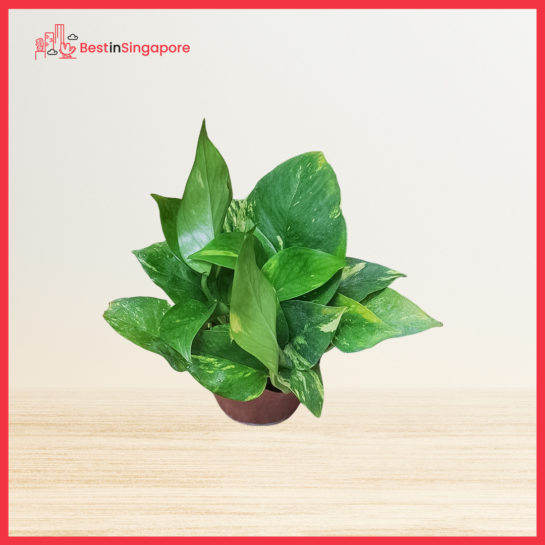
| BEST FEATURE | Known for good luck and success |
| SCIENTIFIC NAME | Pothos golden Epipremnum |
| SIZE | Approximately 9cm (vary in sizes) |
| PRICE | S$5.00 |
If you’re looking for an indoor plant in Singapore that’s said to bring good luck, then look no further than the Money Plant. It’s one of the cheapest and most low-maintenance houseplants on the island, requiring only indirect sunlight to survive.
It may be more known for boosting feng shui energy, but it’s capable of producing oxygen at night to freshen the air as well. It’s similar to snake plants in terms of its air-cleaning properties.
What houseplant owners like the most about it is that it’s extremely easy to find a spot for it. Apart from being a non-complicated plant, its small size allows owners to place it on their bedside table or even hang near any window.
There’s no need to water money plants regularly because they prefer deep but infrequent watering. They’re most comfortable in temperatures that range somewhere between 20 to 30 degrees Celsius, so make sure your home has enough humidity.
We think that this is one of the best indoor plants in Singapore if your place can maintain a temperate climate for the plant.
Pros
- One of the cheapest houseplants
- Low-maintenance houseplant
- Safe around pets
Cons
- Relatively shorter lifespan
3. Rubber Plant
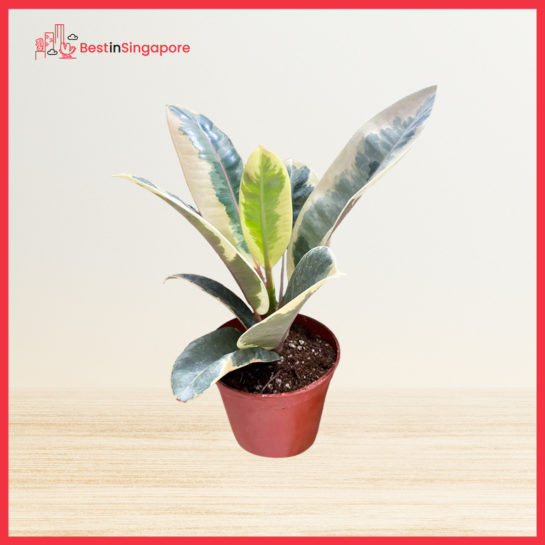
| BEST FEATURE | Safe for people with pollen allergies |
| SCIENTIFIC NAME | Ficus elastica variegated |
| SIZE | Approximately 8cm (vary in sizes) |
| PRICE | $7.00 |
The rubber plant is a budget-friendly indoor plant in Singapore that comes in a variety of attractive colours, including dark green, deep maroon, or spots of white, cream, pink, or yellow. It’s best known for its large, leathery, and glossy leaves that blend well with any home interior.
If there’s an indoor plant that thrives on being neglected, it’d have to be the rubber plant. While other indoor plants beg to be watered regularly and be given a sufficient amount of sunlight and air, a rubber plant will be fine with being watered once a week.
You only need to water rubber plants when the soil is completely dry and cracked, as they actually prefer drier soils. You won’t have to worry about finding a perfectly-lit room because they’re fine with being placed even at a corner of a room.
Rubber plants can remove carbon dioxide, carbon monoxide, and formaldehyde, making them the best indoor plants in Singapore for newly renovated or painted homes so they can help remove the toxic smell.
Pros
- Resilient plant
- Extremely low maintenance
- Affordable
- Safe for pollen allergies
Cons
- Grows faster than most indoor plants
- Can grow large spreading roots
4. Peace Lily
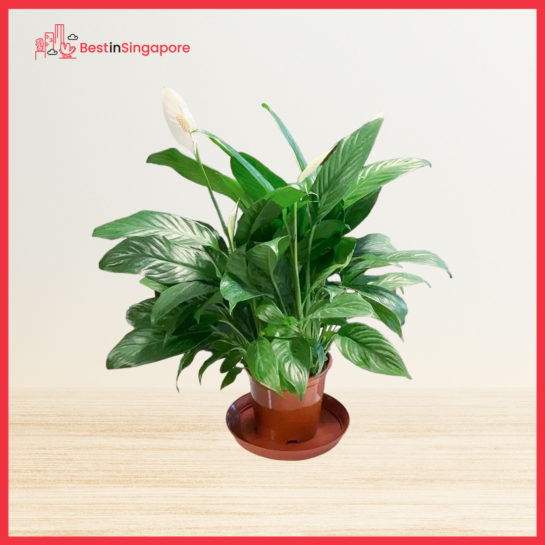
| BEST FEATURE | Grows well in dim rooms |
| SCIENTIFIC NAME | Spathiphyllum hybrid |
| SIZE | Approximately 30cm (vary in sizes) |
| PRICE | S$16.95 |
For homes with minimal lighting, there’s no better indoor plant in Singapore to decorate your rooms with than the Peace Lily. It’s a dim-friendly houseplant that thrives in a shade and needs moderate watering.
It’s slightly expensive compared to our other picks, but that’s forgivable considering its benefits and the number of toxins it can remove from the environment. These toxins are trichloroethylene, benzene, formaldehyde, and ammonia fumes from paint and furniture.
Another benefit of having a peace lily is that increases the transpiration rate, which adds more moisture to the air. We call it one of the best houseplants for those who have extremely dry skin.
It also requires a lot more attention from its owners compared to other indoor plants, but most tend to look past that given its multiple benefits. It even makes it easier for the owner to take care of it by giving signals.
When it needs to be watered, a peace lily will droop. However, one general rule when taking care of plants is to water them whenever the soil is almost dry, so we recommend checking it now and then.
Overall we think this is one of the best indoor plants in Singapore to place in your bedroom so you can frequently check the soil dryness.
Pros
- Can be placed in dim rooms
- Can remove ammonia fumes
Cons
- Expensive for a houseplant
- Requires more attention from owners
5. Bamboo Palm
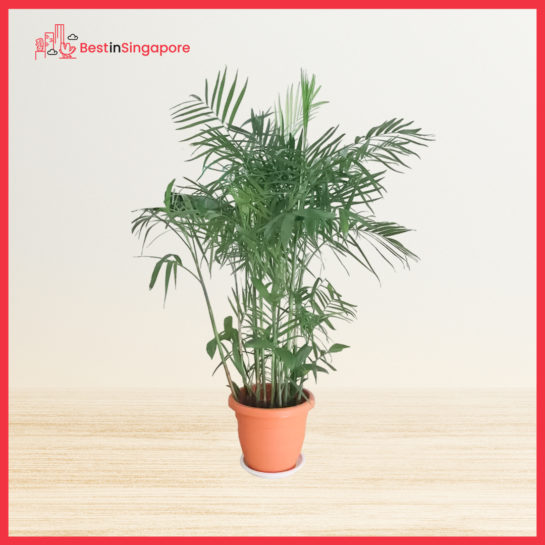
| BEST FEATURE | Cleans dust with negative ions |
| SCIENTIFIC NAME | Chamaedorea seifrizii |
| SIZE | Approximately 120 to 130cm (vary in sizes) |
| PRICE | $55.88 |
If you have extra space at home for a large indoor plant, we recommend getting your hands on a bamboo palm. It’s a well-known NASA-approved air purifying plant that can drive away harmful toxins from the air.
Some of the pollutants that bamboo palms can remove are benzene and formaldehyde gases, among others. Aside from pollutants, they can also drive away viruses, mould, dust, germs, and even spores by producing negative ions.
It’s no secret that most indoor plants in Singapore are capable of producing negative ions. Bamboo palms are more special because they cover large surface areas and pump out negative ions, which then remove more dust and viruses.
In terms of maintenance, be prepared to allot more time and money for it. It should be grown in a fertilised potting mix that consists of coconut fibre, perlite, compost, and other ingredients.
If you have a pet at home, you might want to think twice about getting a bamboo palm because its berries are toxic to animals. Overall, if you want to get rid of toxic vibes, this is the best indoor plant in Singapore to have.
Pros
- Perfect for larger homes
- Can be used as an office plant
- Requires moderate maintenance
Cons
- Tends to be expensive
- Berries toxic for pets
- Not ideal for small homes
6. Anthurium Forgetii
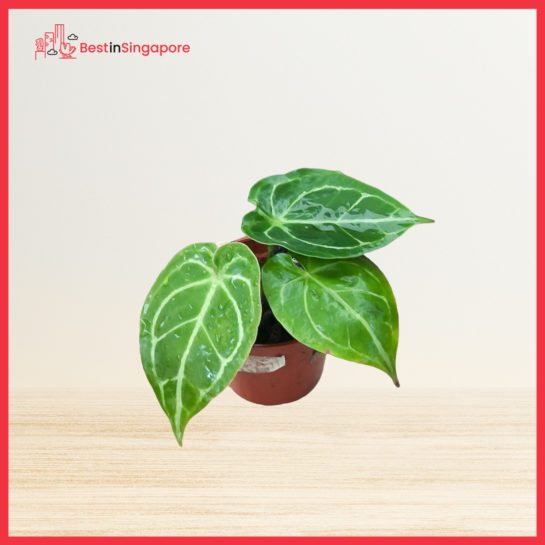
| BEST FEATURE | Can purify and clean air |
| SCIENTIFIC NAME | Sansevieria trifasciata |
| SIZE | Approximately 60cm (vary in sizes) |
| PRICE | S$23.85 |
The Anthurium Forgetti is an indoor plant in Singapore that’s part of the Anthurium species. It’s one that’s native in Columbia.
What sets it apart is that it doesn’t have the normal almost heart-like shape the other members of the species has. This is due to the leaves being completely ovated without upper lobes. And although it rarely blooms flowers, the plant alone with its leaves, is a beauty that can brighten up whatever room you put it in.
Anthurium Forgetii doesn’t require that much attention too, only needing to have moist soil, which you can water once or twice a week, and it can thrive in places with not much direct sunlight.
Because it’s low-maintenance, we think this is the best indoor plant in Singapore for those always on the go but still want a vibrant plant to come home to.
Pros
- Low maintenance
- Medium light environment
- Thrives in branchy and mossy soil
Cons
- Flower blooms only seasonally
- Quite expensive
7. Noah Garden Centre
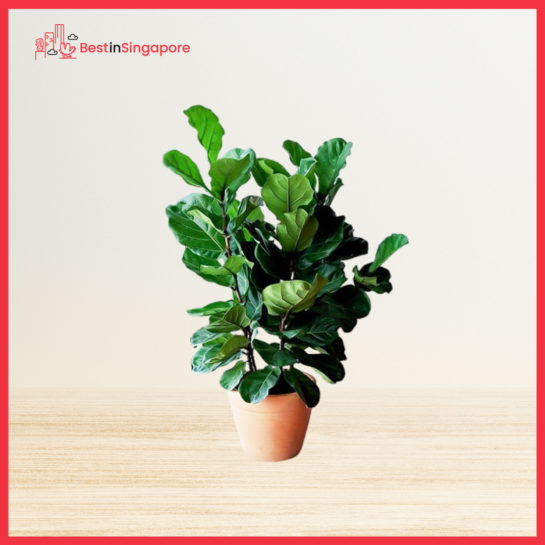
| BEST FEATURE | Offers a wide range of indoor plants |
| SCIENTIFIC NAME | |
| SIZE | Small to Large |
| PRICE | From S$3.00 |
Let’s admit it, due to the pandemic, we became more appreciative of mother nature influencing us to take care of houseplants even more.
With Noah Garden Centre, they are the solution to your garden needs from seeds, pots, and even outdoor and indoor plants. Their website and their company itself is a one-stop-shop for aside from the products they sell, it is also impressive that they also have Gardener Services, Plant Disposal, Design Consultation, and Landscape Maintenance Services.
Compared to other companies, they have Plant Parents Club for plant lovers where you can earn points. By earning points for every S$1 spent, it gets you closer to your next gardening fix.
Pros
- Has a Plant Parents Club
- Has a variety of indoor plants
- Has a 7-day warranty period
- Free delivery for all orders above $100
Cons
- Tedious warranty form
- Poor customer service
FAQS about the Best Indoor Plants in Singapore
If you haven’t had any experience in taking care of indoor plants, we assume that you have multiple questions running through your mind. Luckily for you, we’re here to answer some of the most pressing questions about indoor plants in Singapore and take care of them.
What qualities make for a great indoor plant in Singapore?
Some of the qualities you have to look for in a houseplant are a good root system, foliage, and being free from disease.
A strong root system is one of the most important criteria when looking for the best indoor plants in Singapore. One way to know this is by checking if the roots are thick and have a light colour.
As long as the leaves are colourful, then you’re good to go. A rule of thumb when checking the foliage: if it’s hard to see through it, the foliage is thick enough.
What are the benefits of houseplants?
Apart from improving and brightening a home’s interiors, most indoor plants in Singapore have air-purifying properties that will keep the indoor air circulation fresh and clean in all homes.
Studies have proven that houseplants can improve concentration and productivity by up to 15%, reduce stress levels, and boost one’s mood, so they’re definitely a huge help in people’s mental health.
How long do houseplants usually live?
Generally, most houseplants last for about 2 to 5 years. After that, most of them lose their value as “indoor plants” and stop growing, so it’s best to invest in another houseplant when this happens.
How do I remove bugs on my houseplants?
Bugs are one of the most common enemies of houseplants in Singapore, so they’re not really a big deal. You can get rid of bugs by using an insecticide and spraying it all over the plant, including the stems, the tops of the leaves, and the undersides.
Because soap is not enough to kill the eggs, we recommend spraying insecticide at least three times to halt the bug propagation. If your plant is having a severe infestation, then it’s best to just throw it out.
And that’s it for our picks for the best indoor plants in Singapore. Already made a choice? Tell us all about it!
If you’re looking for other ways to upgrade your home’s interiors, you might want to consult with the best interior designers in Singapore. We feature some of the most trusted and in-demand interior designers that can work with all types of homes in there!

